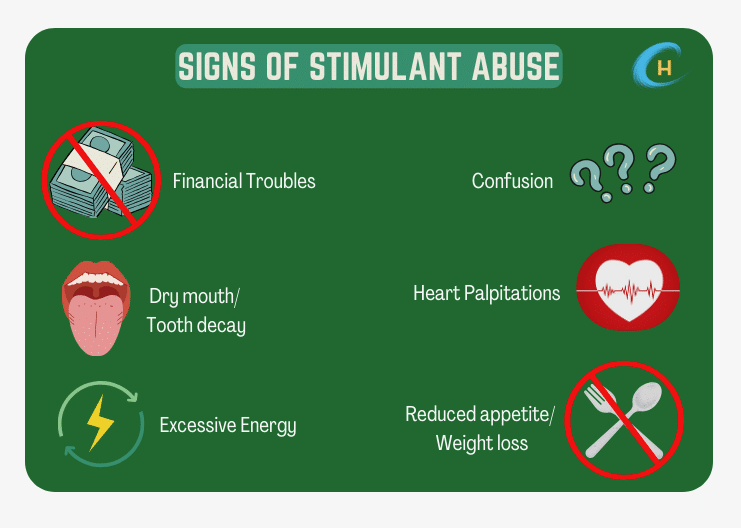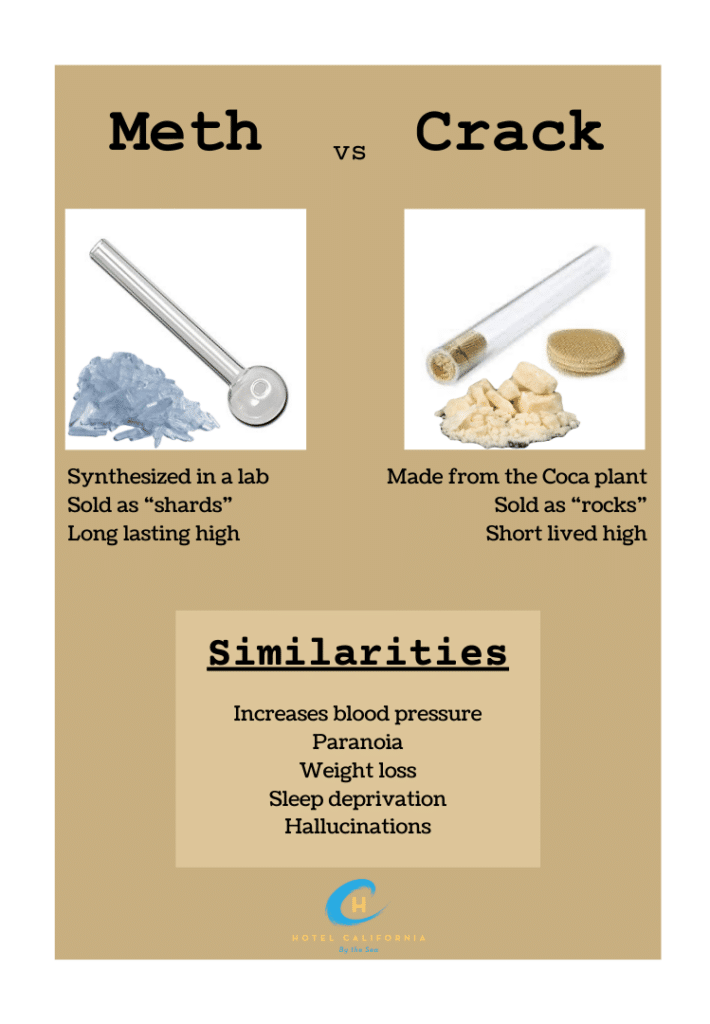Meth vs Crack: What are the differences and similarities between these two commonly abused drugs?
Methamphetamine and cocaine are both powerful and highly addictive stimulant drugs. They affect the central nervous system and produce feelings of increased energy, alertness and a sense of euphoria. They are some of the most commonly abused drugs. In fact, they are sometimes mistaken for each other due to a similar appearance and effect on the brain and body. Though they share many similarities, meth and cocaine are also quite different.

Both meth and cocaine are illegal Schedule II controlled substances with minimal medical uses. When taken, meth and cocaine can produce an intense rush of pleasure making it highly sensitive for those to develop a tolerance, dependence and addiction. They work by blocking the process that normally removes dopamine from the spaces between brain cells. This allows for more dopamine to be available for consumption, which leads to an increase in pleasurable sensations or the “high” the user may be seeking.
What is Meth?
Methamphetamine is an illegal stimulant drug mostly used for recreational purposes. In rare cases, it can be prescribed to treat symptoms of attention deficit hyperactivity disorder or narcolepsy. Meth works by delivering a rapid and intense rush of euphoria and energy that can result in a user going days without food and sleep while taking the drug every few hours. The effects of meth generally last from 6-8 hours and in some cases can go as long as 24 hours.
Common street names for meth include crank, speed and tweak. Meth usually comes in a crystal-like form of rocks and chunks of small glass shards. The odorless powder is bitter-tasting and usually comes in varying shades of white, yellow, orange, or a brownish tint. The meth powder is easily dissolvable in water or alcohol. In some populations in the U.S., meth is an even greater threat than opioids.

Short-term effects of Meth include:
- Euphoria
- Increased energy
- Faster breathing
- Reduced appetite
- Fast or irregular heartbeat
- Increased blood pressure
- High body temperature
- Insomnia
- Erratic and violent behavior
- Hallucinations, panic and psychosis
- Convulsions and seizures
Long-term effects of Meth include;
- Permanent damage to blood vessels, heart, liver and kidney
- Destruction of the nose tissue if the drug is taken intranasally
- Malnutrition
- Meth moth – tooth decay
- Risk of infectious disease
- Psychosis
- Depression
- Severe brain damage and memory loss
- Loss of interest in hobbies
- Criminal behavior and risky behavior
- Skin sores
What is Cocaine or Crack Cocaine?
Cocaine is a stimulant drug derived from the coca plant. It is mostly used for recreational purposes and in rare occasions used medically as a local anesthetic. Crack cocaine is the crystal rock form of the drug and is created by mixing powdered cocaine with other ingredients such as backing soda or ammonia. Crack is actually the purest form of cocaine ranging from 75-100% potency. The term crack got its name from the cracking sounds cocaine makes when it’s being heated up and smoked.
Common street names for cocaine include candy, hardball, kryptonite and beat. The appearance of crack comes in crystalized powdered rocks with an off-white, pink or opaque yellow tint. A 2021 research study found that about 1.4 million people in the United States have cocaine use disorder. Cocaine affects the mesolimbic dopamine system in the brain. This reward pathway is stimulated by reinforcing stimuli such as food, sex and drugs.

Short-term effects of Crack include:
- Euphoria
- Increased energy
- Mental alertness
- Extreme sensitivity to light, sound and touch
- Paranoia and panic
- Fast and irregular heartbeat
- Loss of appetite
- Insomnia
- Hyperstimulation
- Erratic behaviors
- Anxiety and depression
Long-term effects of Crack include:
- Permanent damage to blood vessels
- Risk of heart attack and stroke
- Respiratory failure, lung damage and disease
- Liver and kidney damage
- Risk of infectious diseases
- Severe tooth decay
- Hallucinations
- Disorientation
- Aggression
- Elevated body temperature
- Dilated pupils
Check Your Insurance Coverage for FREE
Find out if your insurance covers addiction treatment in minutes. We accept most insurance!
Meth vs Crack
Both meth and crack are highly addictive stimulant substances. What are the main differences between the two drugs? Meth works by increasing dopamine release into the brain as well as blocking dopamine reuptake. Crack cocaine works by blocking dopamine reuptake. For this reason, meth can produce three times more dopamine and can be more addictive compared to cocaine as it has two different methods of obtaining excess amounts of the feel-good hormone. This is also the reason why meth stays in the body longer than cocaine. However, the duration of effects and how long the substances stay in the body is also dependent on many factors such as history of drug use and pattern of drug use.
- Duration of the effects. Crack cocaine produces rapid and short-lived effects lasting from a few minutes to an hour. On the other hand, meth can produce effects that last as long as 24 hours. Meth also stays in the body for much longer, which is the reason for the long-lasting effects.
- Origin and appearance. Cocaine is derived from the leaves of the coca plant native to South America. Crack is the crystalized rock form of cocaine. Meth is an entirely man-made substance that resembles crystal-clear shards of glass. Meth is made using chemicals such as acetone, anhydrous ammonia, ether, red phosphorus and lithium.
- Drug metabolism. The half-life of cocaine is about one hour, while the half-life for meth is about 12 hours.
- Long-term side effects. Cocaine tends to cause more violent and erratic behaviors in users who abuse the substance. Meth tends to cause aggression and violence. Both substances can lead to symptoms of psychosis, hallucinations, delusions and severe paranoia.
- Method of ingestion. While smoking meth produces a long-lasting high, smoking crack cocaine actually produces a much shorter high. When smoking crack, allows the drug to enter the brain more quickly and brings on an intense and immediate high. The high is however very short-lived.
Reach out to Hotel California by the Sea
We specialize in treating addiction and other co-occurring disorders, such as PTSD. Our Admissions specialists are available to walk you through the best options for treating your addiction.
Treatment for Meth and Cocaine Addiction
Dependence and addiction to powerful stimulant drugs such as meth and cocaine can be difficult to overcome. Detoxing can be dangerous due to physical and psychological side effects. Behavioral health treatment programs such as Hotel California by the Sea provide safe and supportive environments for patients to receive substance use disorder treatment. We offer specialized meth use disorder treatment programs and cocaine stimulant use disorder treatment programs for clients in all stages of addiction and recovery.
Our detox, residential and outpatient programs provide a variety of options for clients when it comes to treatment. In combination with individual and group therapies such as CBT, DBT and EMDR therapy, clients will discover any underlying mental health issues that present alongside their drug addiction. We carefully curate individualized plans for clients that support their journey to sobriety and recovery.
References:
https://carolinacenterforrecovery.com/addiction-blog/crack-vs-meth-what-is-the-difference/
https://www.infiniterecovery.com/substances/crack-vs-meth-whats-the-difference/
https://www.rehabcenter.net/methamphetamine/crack-differences/
https://nida.nih.gov/publications/research-reports/methamphetamine/overview
https://www.drugfreeworld.org/FURL/data/www.drugfreeworld.org/files/truth-about-crack-booklet-en.pdf
https://www.drugfreeworld.org/FURL/data/www.drugfreeworld.org/files/truth-about-crystalmeth-booklet-en.pdf
